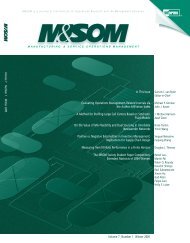Strengthening the Empirical Base of Operations Management
Strengthening the Empirical Base of Operations Management
Strengthening the Empirical Base of Operations Management
You also want an ePaper? Increase the reach of your titles
YUMPU automatically turns print PDFs into web optimized ePapers that Google loves.
Fisher: <strong>Streng<strong>the</strong>ning</strong> <strong>the</strong> <strong>Empirical</strong> <strong>Base</strong> <strong>of</strong> <strong>Operations</strong> <strong>Management</strong><br />
378 Manufacturing & Service <strong>Operations</strong> <strong>Management</strong> 9(4), pp. 368–382, © 2007 INFORMS<br />
progress <strong>of</strong> new product development from company<br />
records ��� � We retained 220 new products for which<br />
complete histories on time to prototype, time to volume<br />
production, and engineering expenditures were<br />
available.” They used <strong>the</strong>se data to identify features<br />
<strong>of</strong> new product development structures that correlate<br />
with a short time to market.<br />
DeHoratius and Raman (2004) worked with a retailer<br />
that audited its stores to identify discrepancies<br />
between <strong>the</strong> quantity <strong>of</strong> a SKU as counted on <strong>the</strong><br />
shelf in <strong>the</strong> store compared with <strong>the</strong> same quantity as<br />
listed in corporate records. They analyzed <strong>the</strong> data to<br />
understand <strong>the</strong> level and drivers <strong>of</strong> inventory record<br />
accuracy.<br />
Mukherjee et al. (1998) used company data on 62<br />
quality improvement projects conducted by N. V.<br />
Bekaert, S.A., <strong>the</strong> world’s largest supplier <strong>of</strong> steel<br />
wire, to determine <strong>the</strong> impact <strong>the</strong>se projects had on<br />
<strong>the</strong> way <strong>the</strong> organization learned.<br />
Existing company data have <strong>the</strong> advantage <strong>of</strong> being<br />
easy to assemble, but those data might not have<br />
all <strong>the</strong> information needed to answer <strong>the</strong> research<br />
questions being addressed, so researchers will <strong>of</strong>ten<br />
augment existing data with additional data collected<br />
for <strong>the</strong> purpose <strong>of</strong> <strong>the</strong>ir research project. As mentioned<br />
previously, Clark and Fujimoto (1991), Jaikumar<br />
(1986), Jordan and Graves (1995), Krafcik (1988),<br />
Macduffie (1991), MacDuffie et al. (1996), and Terwiesch<br />
et al. (2005) all provide examples <strong>of</strong> researchers<br />
constructing a database within a company.<br />
Ano<strong>the</strong>rexample is provided by DeHoratius and<br />
Raman (2007), who worked with an audio electronics<br />
retailer that had changed <strong>the</strong> store manager incentives<br />
<strong>of</strong> ano<strong>the</strong>r retailer it had acquired to reduce <strong>the</strong> incentive<br />
<strong>the</strong> store managers had to minimize inventory<br />
shrink. They found that shrink did indeed increase,<br />
but <strong>the</strong> cost <strong>of</strong> this increase was more than <strong>of</strong>fset by<br />
<strong>the</strong> pr<strong>of</strong>it on increased sales, which resulted because<br />
activities that reduce shrink tend to also reduce sales.<br />
Khanna and Iansiti (1997, p. 413) worked with all <strong>the</strong><br />
mainframe computer manufacturers in <strong>the</strong> world and<br />
“collected observations on all major multichip module<br />
related projects ���through multiple interviews with<br />
<strong>the</strong> key managers and engineers as well as through<br />
questionnaires” to better understand how <strong>the</strong>se firms<br />
allocated resources during different stages <strong>of</strong> a development<br />
project. Sterman et al. (1997) sought to understand<br />
why financial performance at Analog Devices<br />
worsened after a dramatically successful Total Quality<br />
<strong>Management</strong> program that doubled yield, cut cycle<br />
time in half, and reduced defects by an order <strong>of</strong> magnitude.<br />
To do this, <strong>the</strong>y “used econometric estimation,<br />
interviews, observation, and archival data to specify<br />
and estimate” (p. 503) <strong>the</strong> parameters <strong>of</strong> a simulation<br />
model that linked productivity and quality<br />
variables with accounting systems. Ton and Raman<br />
(2005) worked with a book retailer that was concerned<br />
about what it called “phantom stock outs,” instances<br />
in which a book was in a store but could not be found<br />
in response to a customer request. They tabulated data<br />
on instances <strong>of</strong> phantom stock outs and used <strong>the</strong> data<br />
to assess <strong>the</strong> level and causes <strong>of</strong> phantom stock outs<br />
as a precursorto designing countermeasures.<br />
In all <strong>the</strong> above examples, <strong>the</strong> data are about companies,<br />
gleaned from public or internal sources. Ulrich<br />
and Pearson (1998) sought to understand product<br />
design issues by directly examining products. Using<br />
an approach <strong>the</strong>y called “product archaeology,” <strong>the</strong>y<br />
took apart 20 c<strong>of</strong>fee makers, estimated manufacturing<br />
cost using techniques from Design for Manufacturability,<br />
and <strong>the</strong>n correlated cost with attributes <strong>of</strong> <strong>the</strong><br />
product’s design to understand how design attributes<br />
influence cost.<br />
As well as directly observing products, a researcher<br />
can directly observe processes. MacDuffie (1997) spent<br />
one week each at a GM, Ford, and Honda plant, documenting<br />
and comparing <strong>the</strong>ir approaches to solving<br />
waterleaks, paint defects, and electrical defects.<br />
Unlike o<strong>the</strong>r examples I have cited, his results were<br />
comprised <strong>of</strong> qualitative descriptions <strong>of</strong> <strong>the</strong> processes<br />
used in each <strong>of</strong> <strong>the</strong> plants, but <strong>the</strong>y are none<strong>the</strong>less<br />
interesting forthat fact. In a similarfashion, Tucker<br />
(2004, p. 4), “a management researcher with a background<br />
in quality engineering in manufacturing settings,<br />
spent 239 hours shadowing 26 different nurses<br />
at nine hospitals and recording detailed information<br />
about <strong>the</strong>irwork activities” to betterunderstand how<br />
<strong>the</strong>y dealt with operational failures.<br />
Experimentation is a standard tool <strong>of</strong> empirical<br />
research, a tool that has also proven useful to operations<br />
management researchers. Experiments can be<br />
conducted in a laboratory type setting or in a company.<br />
One example <strong>of</strong> laboratory experimentation<br />
already mentioned is <strong>the</strong> beer game (Sterman 1989),<br />
which asks students to make supply decisions in <strong>the</strong>




